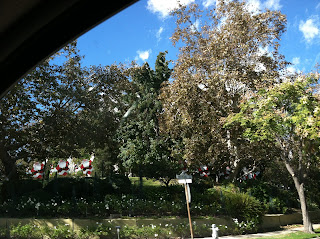I knew Disneyland would be crowded because it was Thanksgiving weekend, but the word "crowded" does not even do this story justice. The parked was packed on this particular Saturday, and it was not even an enjoyable day for me because of the crazy lines for both food and rides. What overwhelmed me most was thinking about the fact that every single person there had paid at least $100 at some point or another to visit this park for one day (except passholders, but still, passes are expensive!). Paying over $100 to go to a crowded place and stand in a lot of lines seemed pretty absurd to me. Most people that go to Disneyland just spend more money, whether it may be for meals, souvenirs, or parking. The variety of people there also amazed me, as there were people from every race and age present. I spotted old couples, young couples, families with young children, and groups of teenagers.
While observing all of these people, I thought of Wilford's lecture on Axes of Difference, and how the city can be a tool for reproducing labor. Workers are happy when they can use their wages for entertainment purposes, and Disneyland is a prime example of this. If workers can go to places like Disneyland on the weekends, they will work hard during the week with that reward in mind.
In an article on Yahoo! News, I learned that Disneyland has increased ticket prices by an amount between $2 and $7 each year for the past 10 years. In spite of the recent economic downturn, Disneyland still seems to be doing well and people from both working and middle class still buy tickets. It seems to me that people of the upper class aren't as enthused with Disneyland compared to those of the middle class, and I would like to research this more. In my experience, families that don't have quite as much money spend their money on theme parks like Disneyland, and wealthier families tend to spend their money on more elaborate vacations and luxuries. I began to wonder if the middle class and lower class families I spotted at Disneyland owned a pass, or if this was the one-time-a-year visit that they made.
In any case, with this visit, I found that both the struggling and the glamorous residents of Los Angeles are willing to spend a large amount of their income to visit Disneyland for one day (including me!). In his article, "Neoliberalism as Creative Destruction", David Harvey explains that neoliberalism only makes the rich richer and the poor poorer. He and other critics argue that it is unfair for the poor to have to pay for things like toll roads when the city used to be seen as a public infrastructure that is accessible to all. What I learned at Disneyland is that no matter how much money people make, they find a way to afford a ticket to Disneyland. I am not saying that the lowest class can afford a ticket to Disneyland, but it does seem to me that people with lower incomes attend the park. Every family spends their money in different ways, and in this neoliberalist era, it doesn't seem like the middle class is suffering as much as critics like Harvey and Polanyi make it sound. If they can afford a ticket to Disneyland, they can surely afford to ride on the toll road every once in a while.
Yahoo! News Article:
http://news.yahoo.com/disneyland-ticket-prices-increased-144100616.html
Me on Splash Mountain- Okay, I guess I had SOME fun!



















